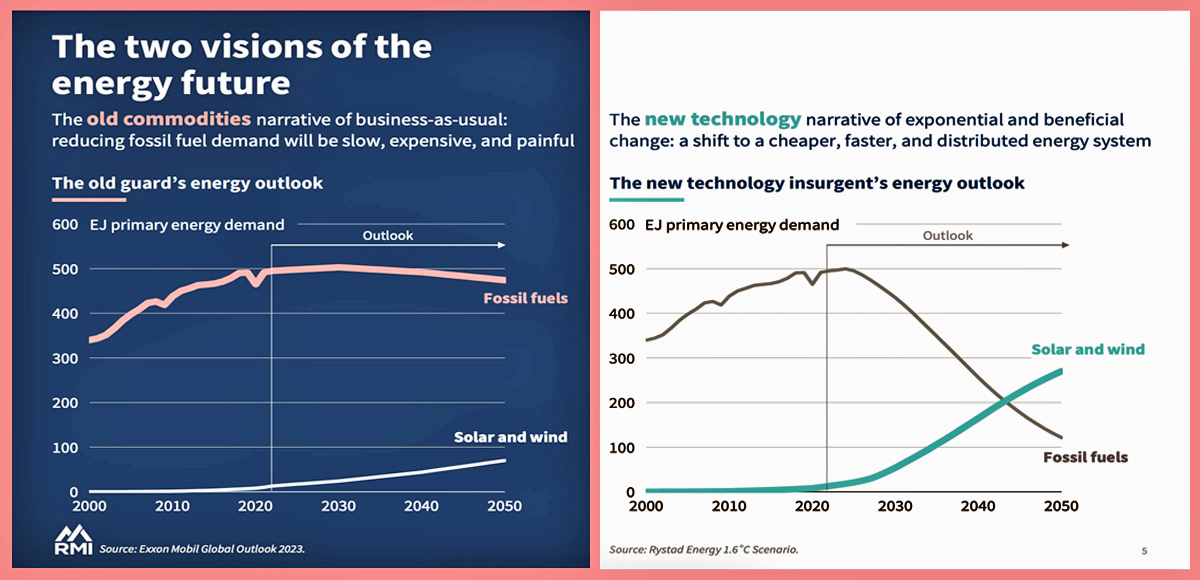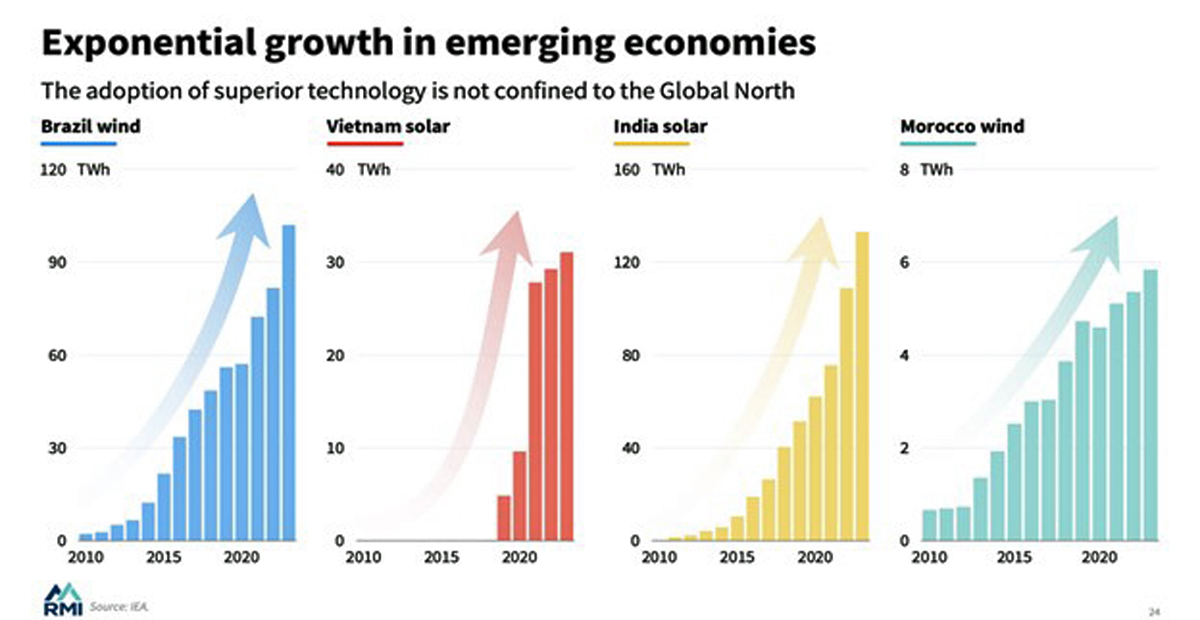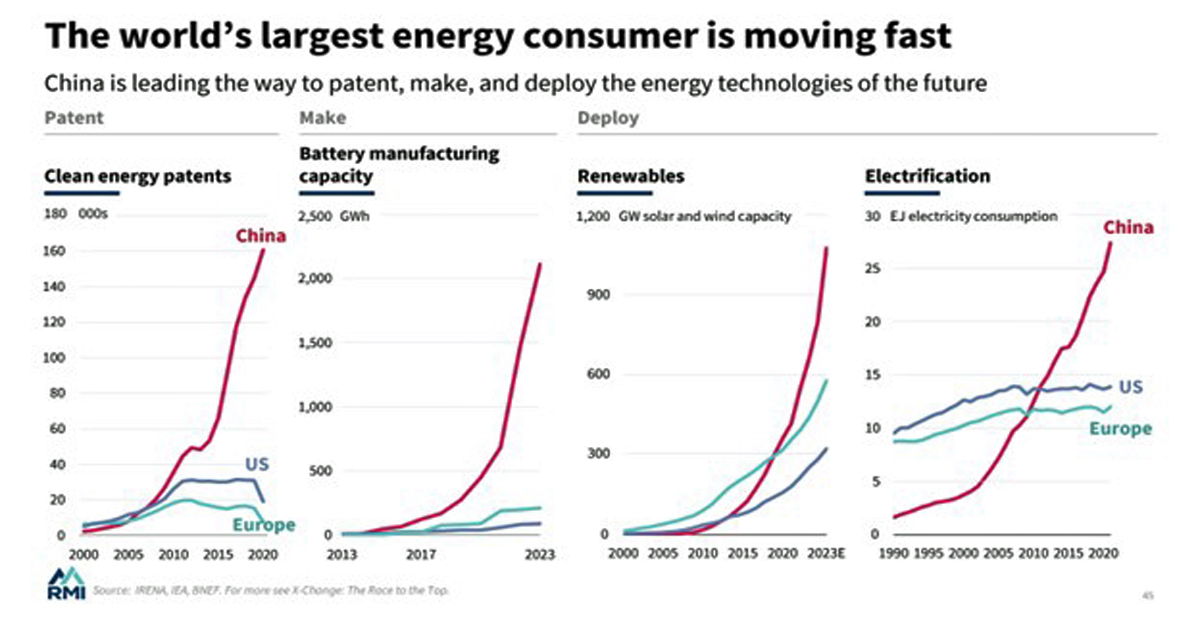Two Energy Visions: Old Commodities vs New Technologies
by Kathleen Biggins
Which energy future do you want?
Take a look at these two graphs, one from Exxon and one from Rystad Energy (a highly respected energy consultant), depicting two very different paths. In Exxon’s view, fossil fuels continue to dominate to midcentury at near their current level of use. In Rystad’s projection, fossil fuels face a rapid decline as renewables increasingly replace them within our global energy system.

The Trump administration prefers Exxon’s vision – and is doing everything it can to ensure that this future arrives. We are the world’s number one producer of oil and gas, and the administration sees those resources as a way to cement our energy dominance.
But many in the rest of the world, especially within the 74% of the global population that lives in countries dependent on fossil fuel imports, prefer the second vision. They do not want to be dependent on and beholden to any petro-rich country, especially at a time when alliances are being disrupted and devalued. In the olden days, when fossil fuels were the only game in town, they didn’t have a choice. Now, increasingly, they do.
While the current administration is trying to discredit and minimize renewable energy, the truth is that wind, solar, and batteries are outpacing fossil fuels at a breathtaking rate. Last year, 92% of the world’s new power generation came from renewable sources, and renewables are predicted to provide half of global electricity by 2030.
Why are renewables growing so fast? Because they are so darn cheap compared to fossil fuels, providing savings of more than 40% for solar and 50% for wind on a global average. And with new, improved, cheaper batteries, renewables can handle an even bigger portion of our electricity supply. A recent study shows just how important batteries are to the mix, projecting that sunny places like Las Vegas could potentially get almost all of their power supply from solar when enough battery backup is built.
Here’s the clincher. Wind, solar, and batteries are expected to continue to decrease in price dramatically, with Bloomberg New Energy Finance projecting a 31% drop in the cost of utility solar by 2035 and a whopping 50% drop in battery costs on a global scale. This means natural gas will face increasing economic disadvantages even in the U.S., where the prices are much lower than in most other countries.
At the same time that renewable energy is dropping in price and able to carry more of the power load, electrification of our transportation and HVAC systems (and, to some degree, our manufacturing processes) is displacing fossil fuels even further.
For example, 20% of total car sales globally were EVs last year. Here’s how important that is: EVs displaced more than 1 million barrels per day of oil consumption in 2024. Given the expected global trajectory of EVs – to triple in number by 2030 – increasing levels of oil will be displaced in the future.
Because of these new realities, more countries – including energy-hungry developing economies – are jumping onto the energy-transition bandwagon. They recognize that pivoting toward renewables gives them not just more energy independence, but cheaper power (solar provides energy at half the price of new coal-powered plants in India), faster energy (solar and batteries can be built much faster than new fossil fuel plants), and less pollution and climate damages.

And the world’s second-largest economy, China, is spending heavily to push its own energy transition faster and to export cleantech to developing countries. So much of China’s economy is now powered on clean electricity that it has been dubbed the world’s first “electrostate.” In April alone, China added more solar than Australia’s entire solar power capacity, and is on track to own half of the world’s renewable energy capacity by 2030. And 2024 was a milestone year: China’s emissions dropped for the first time because of its clean-energy additions, and the clean-energy sector grew to contribute more than 25% of China’s GDP growth and account for 10% of its economy.

These trends are critically important. Emerging and developing economies, including China, are projected to be responsible for 85% of the world’s growing energy demand.
As we look at the energy landscape, it is easy to get caught in cross currents happening on our own shores: skyrocketing electricity demand from AI, crypto mining, and increased air-conditioning; the sclerotic pace of grid upgrades; the growing NIMBYism against clean-energy projects; and the Trump administration’s efforts to stop the growth of renewables.
But when we look at the global picture, we need to recognize that something fundamental has changed. Access to fossil fuels once equated with economic and national security. Clean energy was a “sacrifice,” something we spent more on today to potentially decrease climate threats tomorrow. But now, homegrown energy, of which renewables and batteries are the cheapest and most readily accessible, can provide the vast majority of countries with better economic and national security benefits. And those benefits are even greater when we factor in the avoided costs of climate impacts.
Most countries’ self-interests are pushing them to transition as quickly as is feasible. It’s no longer about doing the right thing for the future – it’s about doing the smart thing for the present. On the global scale, the old order is changing. The old guard just hasn’t accepted that yet.


